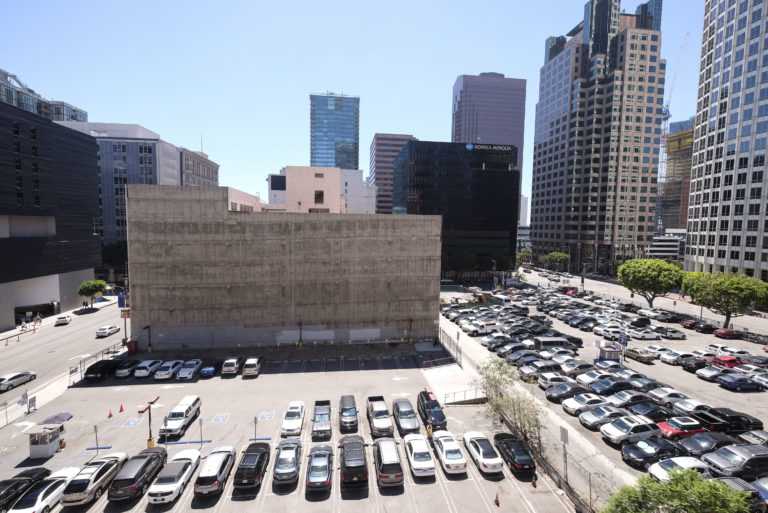
While the transformation of downtown has undoubtedly revitalized L.A.’s urban core, business owners from South Park to the Arts District to Chinatown
have been shaken by an unfamiliar specter: expensive parking.
For political consultant and attorney Stephen Kaufman, whose office is in the 777 Tower at the FIGat7th complex, these costs have risen steadily for the past five or six years. Kaufman, who pays for his staff’s parking at an adjacent lot, said costs have almost doubled over that period, rising to $225 a person per month from about $135.
“It’s not an insignificant dent on my bottom line,” Kaufman said, noting that more than a dozen of his employees park in the lot.
Justin Weiss, a vice president at real estate brokerage Kennedy Wilson in downtown, said the trend is pervasive in the area.
“I don’t know of any lot where the cost of parking hasn’t gone up by at least 10 to 15 percent in the last couple of years,” he said. “It’s becoming much more of a commodity.”
Those within the parking industry said the price surge is driven by several factors. For starters, new high-rise developments and other construction projects in downtown are rapidly replacing many of the old surface lots. Meanwhile, office space is in the area is being gobbled up, according to Weiss, leading to more commuters looking for parking.
Add in the migration of Angelenos to downtown’s hot residential scene as well as construction workers building new projects and you get a wholly transformed supply-and-demand equation for parking in the city’s center, according to Kevin Litwin, chief operating officer of Joe’s Auto Parks, a division of downtown-based parking giant L&R Group.
According to data provided by L&R, downtown is projected to lose nearly 8,000 parking spaces between summer 2014 and the end of this year.
“There’s been a significant change in our rate structures over the past two to three years,” Litwin said. “In some areas – for example near the new Korean Air Tower and the Metropolis development near L.A. Live – prices have doubled.”
The parking crunch will likely become even more acute in the foreseeable future as new development brings retail, residential, and office space – and with them more cars – to downtown. While projecting hard numbers is not an exact science, Litwin said the parking space deficit could be massive.
“We could be looking at a Rose Bowl-sized daily shortage of parking in downtown L.A. by 2020,” he said.
And the lots are not the only spaces affected. Street parking in downtown has also evolved in the last half-dozen years. In August 2010 the city’s Department of Transportation instituted its ExpressPark program complete with “smart” meters that take credit card payments and can sense whether a spot is occupied or not. The program also implemented dynamic pricing, which enables the city to change parking prices quarterly depending on demand.
That means that prices at downtown meters range from 50 cents to $6 an hour and can fluctuate during different times of the day.
Part of plan?
While business owners such as Kaufman might not be pleased with the increased parking costs, the outcome is actually a byproduct of the city’s environmental initiatives.
As part of L.A.’s Greater Downtown Housing Incentive, developers are given incentives to build fewer parking spaces, which are typically the least cost-efficient use of real estate, according to Weiss and others. Those incentives come as new public transportation options enable commuters to ditch their cars for rail lines and buses.
Weiss said changing Angelenos’ attitudes will require sustained effort.
“L.A. has been an awkward teen when it comes to city planning for 70 years,” he said. “But you’re starting to see that change. Angelenos’ mentality about parking and cars in downtown is going to have to change, too.”
Ultimately, downtown might resemble something more akin to New York, Chicago, or San Francisco when it comes to how people get around and what they will pay to operate a vehicle in the city’s core.
“People will have to pay a premium for parking just like they do in other major cities,” Weiss said. “The days of going to a meeting at an office on Bunker Hill and then driving over to your next one in South Park are rapidly coming to a close. It will be like New York City: You park in one spot and then walk or take public transit or an Uber to get around.”
That prospect offers little comfort to Kaufman, who said he is still stuck paying for employee parking due to the practicalities of transportation in the region.
“I certainly encourage employees to take public transportation but it’s just not feasible in many cases,” he said.
Donald Shoup, an urban planning professor at UCLA who studies parking, has little sympathy for employers.
He said the downtown crunch is more perception than reality, stemming from years of having an unparalleled parking supply compared with other cities. In fact, he said L.A.’s core has more parking spaces than any other large city in the country.
Litwin added that parking prices in places such as Cleveland are still routinely higher than in Los Angeles.
“I mean, come on,” he said. “Cleveland? Ohio?”
